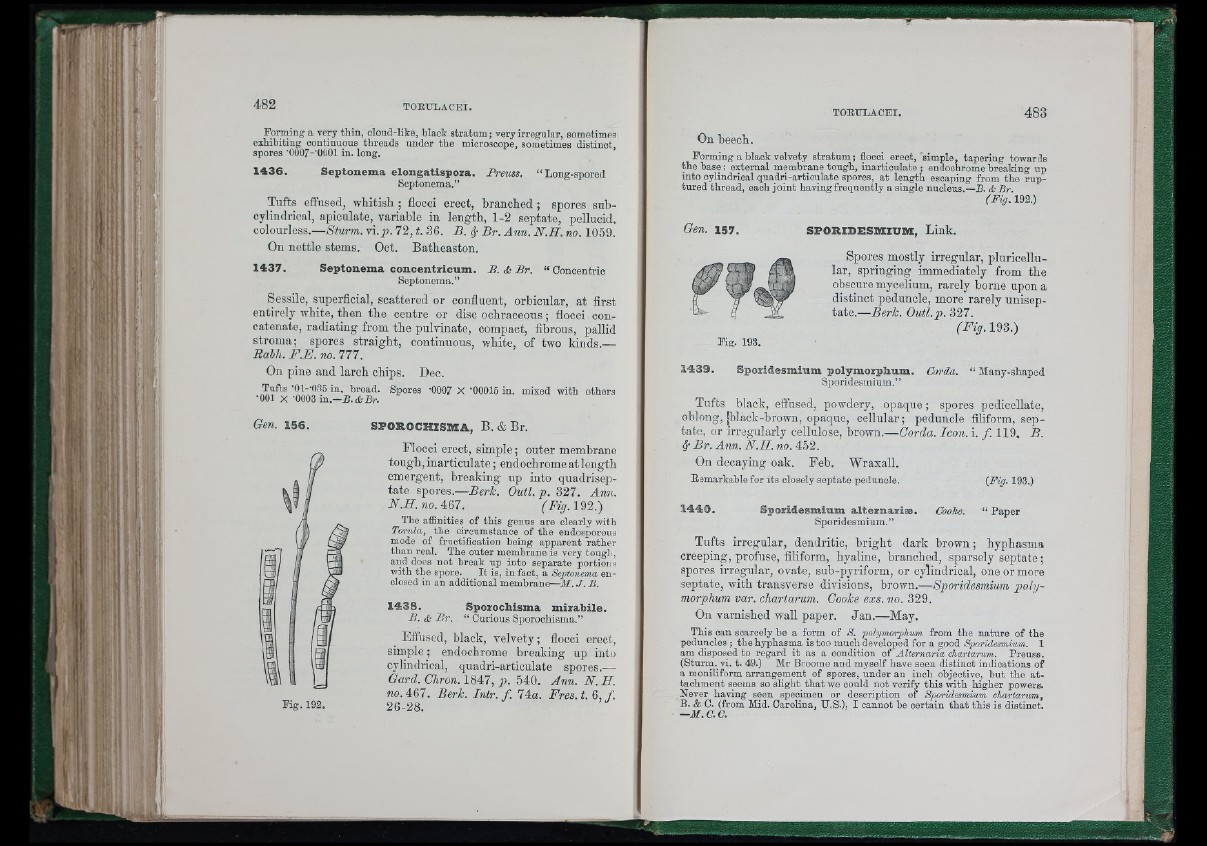
! 'i
I
í-i ^
í\
Forming a v e ^ thin, cloud-like, black stratum; very irregular, sometimes,
exhibiting continuous threads under the microscope, sometimes distinct,
spores 'OOOr-'ÜÜOl in. long.
1 4 3 6 . S ep to n em a e lo n g a tisp o r a .
Septonema.”
Preuss. “ Long-spored
Tufts effused, whitish ; flooci erect, branched ; spores sub-
cylindrical, apiculate, variable in length, 1-2 septate, pellucid,
colourless.—Sturm, vi.ji. 72, t. 36. B . 4 Br. Ann. N .H . no. 1059.
On nettle stems. Oct. Batheaston.
1 4 3 7 . S ep to n em a c o n c en tz icum . B .A B r . “ Concentric
Septonema.”
Sessile, superficial, scattered or confluent, orbicular, at first
entirely white, then the centre or disc ochraceous; flocci concatenate,
radiating from the pulvinate, compact, fibrous, pallid
stroma; spores straight, continuous, white, of two binds.—
Bahh. F .E . no. 777.
On pine and larch cbips. Deo.
Tufts -Ol-'OSS in. broad. Spores '0007 X '00015 in. mixed with others
•001 X 'OOOSiu.—B.ifeBr.
Gen. 1 5 6 . SFOROCHISIHA, B. & Br.
Flocci erect, simple; outer membrane
tougb, inarticulate; endochrome atlength
emergent, breaking up into qnadrisep-
tate spores.—Berk. Outl. p. 827. Ann.
N .H . no. 467. (Fig. 192.)
The affinities of this genns are clearly with
Torula, the circumstance of the endosporous
mode of fructification being apparent rather
than real. The outer membrane is very tough,
and does not break np into separate portions
with the spore. I t is, in fact, a Septonema enclosed
in an additional membrane—M. J . B.
1 4 3 8 . Sp o zo chisma m iz a b ile .
B. A B r. “ Curious Sporochisma.”
Effused, black, velvety; flocoi erect,
simple; endochrome breaking up into
cylindrical, qnadri-articulate spores.-—
Gard. Ghron. 1847, p . 540. Ann. N. H.
no. 467. Berk. Intr. f. 74a. Fres. t. 6, f.
26-28.
On beecb.
Forming a black velvety stratum; flocoi erect,'simple, tapering towards
the base; external membrane tough, inarticulate ; endochrome brealdng np
into cylindrical quadri-articnlate spores, at iength escaping from the ruptured
thread, each joint having frequently a single nucleus,—B. A Br
(Pig. 192.)
Gen. 1 5 7 . S F O R ID E S ia iV ia , Link.
Spores mostly irregular, pluricellu-
lar, springing immediately from the
obscure mycelium, rarely borne upon a
distinct peduncle, more rarely uniseptate.—
Berk. Outl.p. 327.
(Fig.193.)
1 4 3 9 . S p o zid esm ium p o lym o zphum .
Sporidesmium.”
Ooi'dcL. “ Many-shaped
Tufts black, effused, powdery, opaque ; spores pedicellate,
oblong, ¡black-brown, opaque, cellular; peduncle filiform, septate,
or irregularly cellulose, brown.— C'orcfa. Icon. i. / . 119. B.
4 B r. Ann. N.H. no. 452.
On decaying oak. Feb. Wraxall.
Remarkable for its closely septate peduncle. {Fig. 193.)
1 4 4 0 . Sp o z id e sm ium altezua z ise.
Sporidesmium.”
Cooke. “ Paper
Tufts irregular, dendritic, bright dark brown; hyphasma
creeping, profuse, filiform, hyaline, branched, sparsely septate;
spores irregular, ovate, sub-pyriform, or cylindrical, one or more
septate, with transverse divisions, brown.— Sporidesmium pohj-
morphum var. chartarum. Cooke exs. no. 329.
On varnished wall paper. Jan.—May.
This can scarcely be a form of S. polymorphum from the nature of the
peduncles ; the hyphasma is too much developed for a good Sporidesmium. 1
am disposed to regard it as a condition of Alternaria chartarum. Preuss.
(Sturm, vi. t. 49.) Mr Broome and myself have seen distinct indications of
a moniliform arrangement of spores, under an inch objective, bnt the a ttachment
seems so slight that we could not verify this with higher powers.
Never having seen specimen or description of Sporidesmium chartarum,
B. <k 0. (from Mid. Carolina, U.S.), I cannot be certain that this is distinct.
-M . c. a